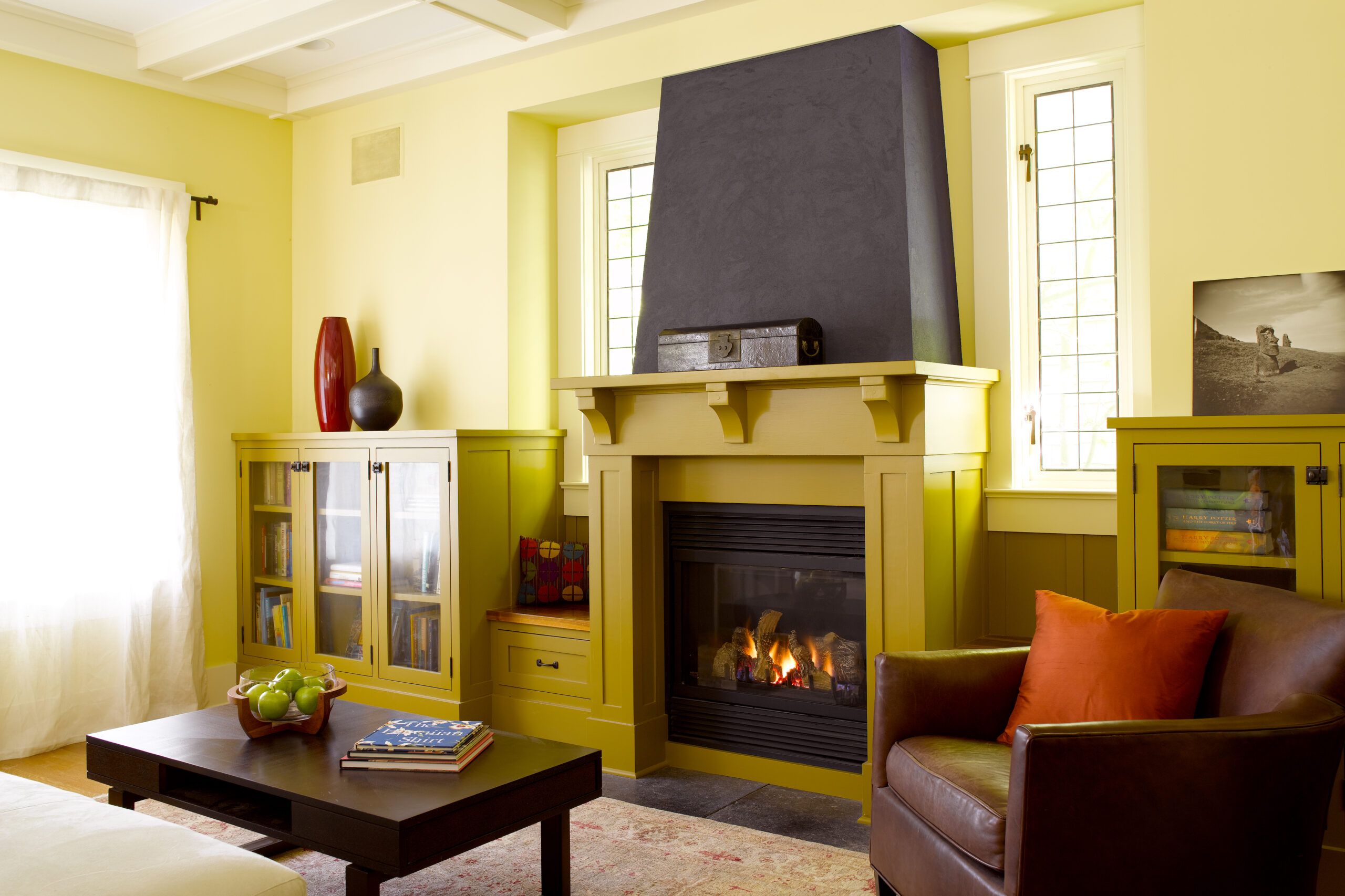Imagine the warmth and ambiance of a crackling fire, without the hassle of chopping wood, tending flames, or cleaning up ashes. That’s what you get with today’s gas fireplaces. Modern gas fireplaces offer stunningly realistic flames, glowing embers, and efficient heat—all at the flick of a switch.
Whether you’re looking to transform an existing wood-burning fireplace or create a cozy new focal point, we’ll help you pick the right gas fireplace for your space. Our guide explains how gas fireplaces work, the different types available, key features to consider, maintenance tips, and more. When the weather turns cold, you’ll be ready to relax in front of a cozy and convenient gas fireplace.
How Do Gas Fireplaces Work?
Gas fireplaces create the illusion of a wood-burning fire without the associated mess or maintenance. Rather than burning wood, they use either natural gas or propane. Here’s how it works:
- Fuel delivery: A line connected to your home’s natural gas or propane supply delivers fuel to the fireplace.
- Ignition: An electronic ignition system (or pilot light, in some older models) sparks the natural gas or propane, creating a flame.
- Combustion: The gas mixes with air and ignites, producing heat and flames that dance around artificial logs.
- Venting: Byproducts like water vapor and carbon dioxide are either vented outside or treated to minimize emissions.
Gas Fireplace Components
The design of gas fireplaces may vary depending on the type, placement, and venting system, but they generally share the same basic components:
- Firebox: A metal enclosure that houses the burner, logs or other media, and often a heat exchanger.
- Ignition system: A system that ignites the gas, either electronically or with a pilot light in older models.
- Burner: The component that mixes gas and air for combustion, creating the flames.
- Media: Ceramic or other heat-resistant materials, often designed to mimic the logs used for a wood fire. Some models offer contemporary media options like glass or stones.
- Glass front or metal screen: In vented models, a tempered glass panel provides a clear view of the flames and helps contain the heat. Some ventless models also have a glass panel, while others have a metal safety screen. Some built-in and stand-alone models have multiple glass panels for a see-through or panoramic look.
- Venting system: In a direct-vent system, a pipe or duct may carry the exhaust gases outside. A system with a natural vent relies on the natural draft of the chimney or vent pipe to pull the exhaust gases up and out of your home. Some models are entirely vent-free.
- Outer trim or surround: Some inserts have an outer trim kit that can be used to cover gaps between the insert and the fireplace opening. Freestanding models, meanwhile, typically have a decorative frame of stone, tile, or another non-combustible material surrounding the firebox.
- Controls: A panel or remote that allows you to adjust flame height, heat output, and other features.
- Blower: Some models have a fan that circulates warmed air from the firebox into the room.
- Heat exchanger: A system of metal fins or tubes that absorbs heat from the firebox and transfers it to the room air, increasing the fireplace’s heating efficiency. Not all models have this component.
- Oxygen depletion sensor (ODS): Ventless gas fireplaces have a sensor that automatically shuts off the gas supply if it detects low oxygen levels in the room.
Venting Options
Gas fireplaces have one of three different venting systems—natural, direct, or ventless.
- Natural vent: Natural or B-vent fireplaces use your home’s air for combustion and send exhaust gases outside through a chimney or pipe. Though natural venting is less efficient than other options, it’s the simplest choice if you’re installing a gas fireplace inside an existing wood-burning fireplace.
- Direct vent: Direct vent fireplaces have a sealed combustion system with two pipes that extend through the roof or an exterior wall. One pulls in outdoor air for combustion, while the other directs exhaust gases outside. The direct vent setup is more efficient and better for indoor air quality, and it gives you more placement options.
- Ventless: Ventless or vent-free fireplaces burn gas so cleanly that they do not require venting at all. They are typically smaller and less powerful than vented fireplaces, but you can put them almost anywhere. However, ventless fireplaces are banned in California and some U.S. cities due to air quality concerns.
Types of Gas Fireplaces
You can choose from four main types of gas fireplaces, each with its own pros and cons. Gas fireplace inserts fit into an existing masonry fireplace, while built-in models are integrated into a wall during construction or renovation. Stand-alone gas fireplaces offer the most flexible placement, and log sets give you the look of a fireplace with a lower price and much less heat.
Here’s a quick breakdown of the options:
| Placement | Heat Output | Venting | Design Options | Cost | |
| Inserts | Inside existing fireplace | High | Natural or direct, though ventless is possible | Limited | Moderate |
| Built-Ins | Built into wall or structure | High | Natural, direct, or ventless | Customizable | High |
| Stand-Alones | Freestanding | Medium to high | Direct or ventless | Wide range | Moderate to high |
| Log Sets | Inside existing fireplace | Low | Natural or ventless | Limited | Low |
Insert Gas Fireplaces
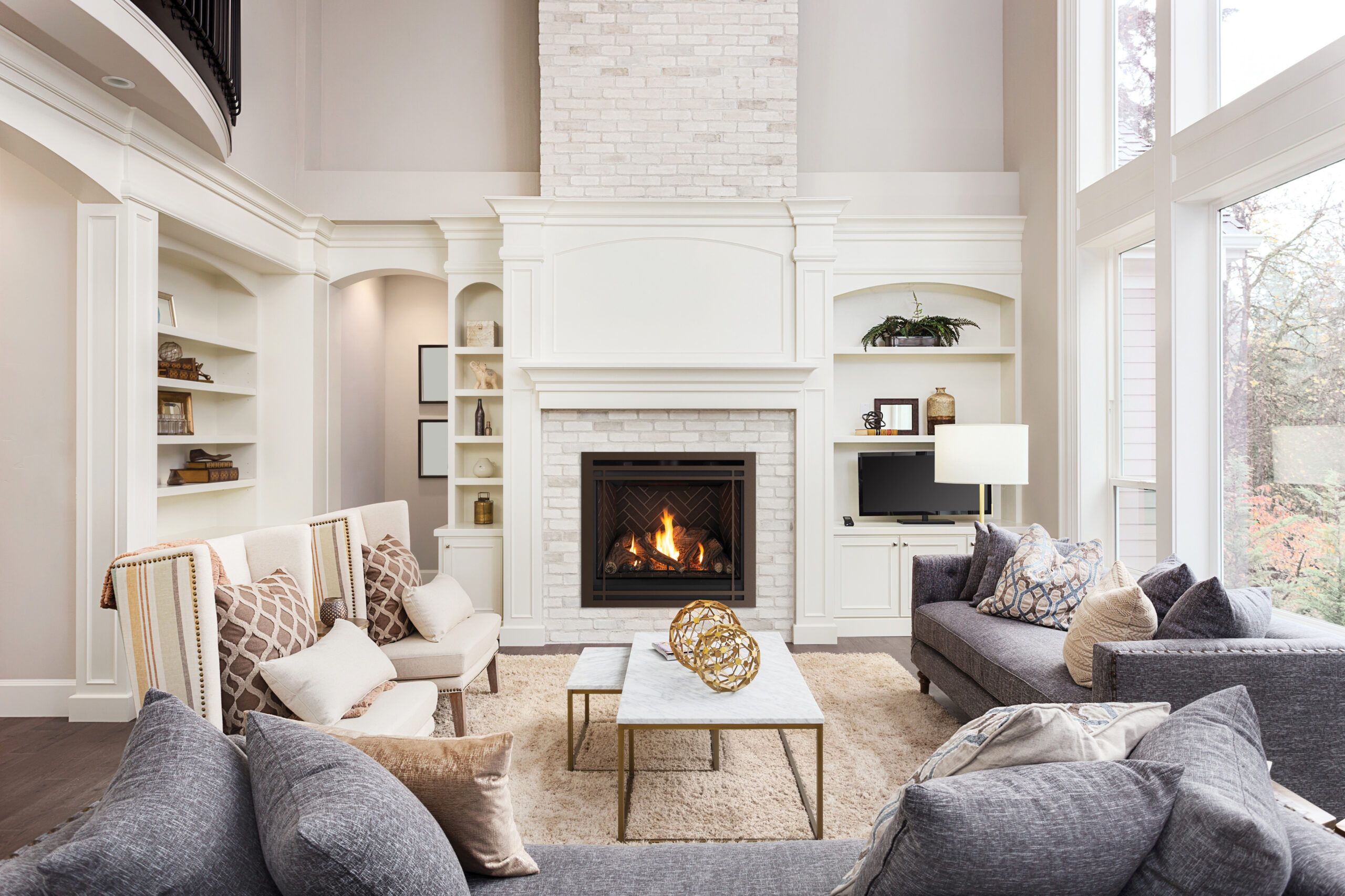
Gas fireplace inserts are designed to fit into an existing fireplace opening, modernizing its look and function. They are significantly more efficient than wood-burning fires, producing more heat with less fuel. They may also offer enhanced safety features like automatic shut-off and oxygen depletion sensors. However, vented models require professional installation, and design options may be limited.
To learn more about installing a gas fireplace insert, check out the video below with Richard Trethewey and fireplace specialist John Sullivan.
Built-In Gas Fireplaces
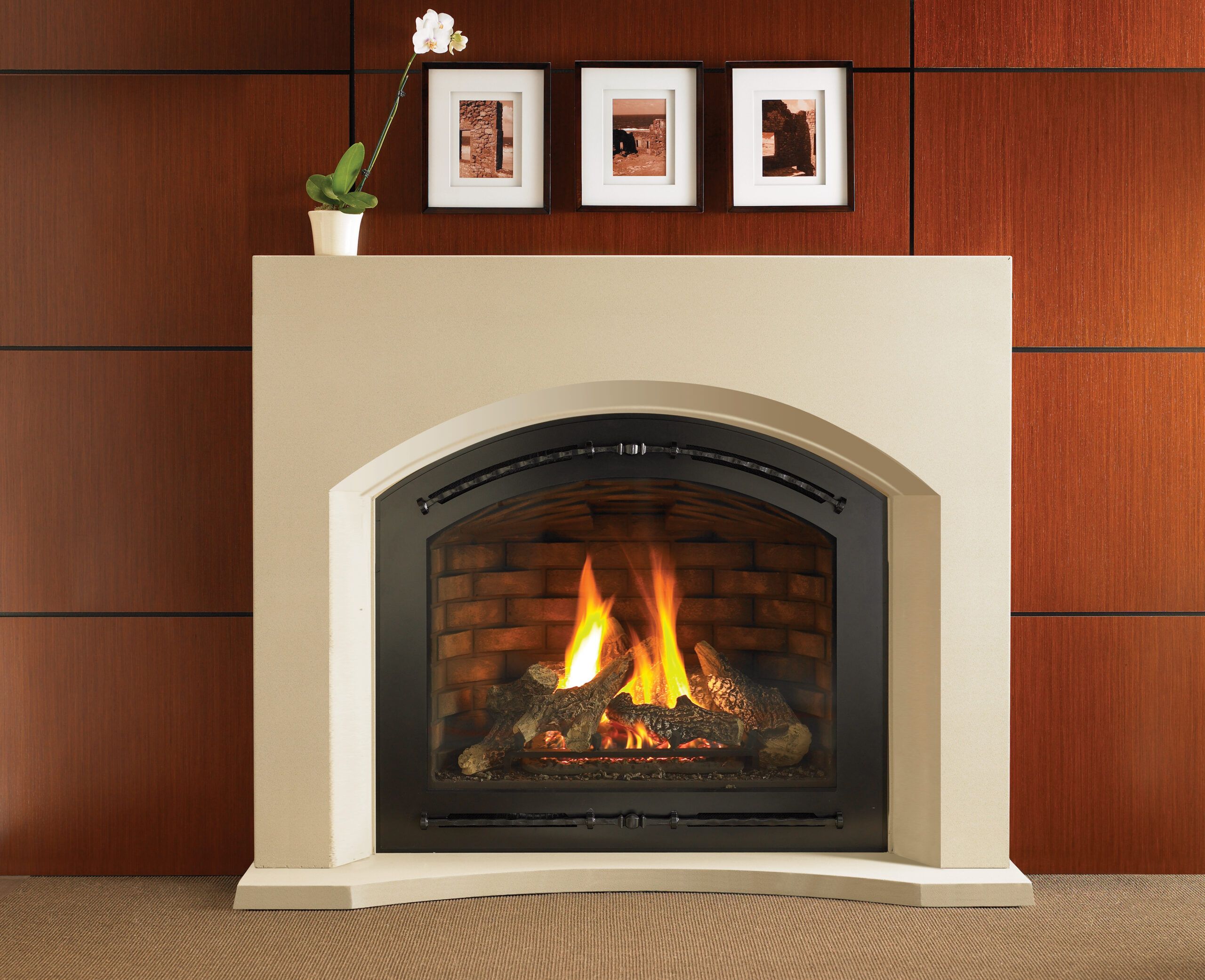
Built-in gas fireplaces are integrated directly into the wall or structure of a home, creating a seamless and stylish focal point. They offer a highly customizable design and efficient heat output, and they don’t require an existing fireplace or chimney. However, built-ins are typically installed during construction or major renovation, and they tend to cost more than a gas fireplace insert. You will also need to check local building codes before installing a ventless model.
Stand-Alone Gas Fireplaces
Stand-alone gas fireplaces do not require an existing fireplace, so they can be placed almost anywhere—especially if you opt for a ventless model. These freestanding units come in a wide range of styles and sizes, and they can be moved if needed. Some models produce almost as much heat as a built-in fireplace, which makes them a viable option for primary or supplemental heating. However, stand-alone fireplaces take up more floor space than inserts or built-ins, and the cost can vary widely depending on size, features, and design.
Log Sets
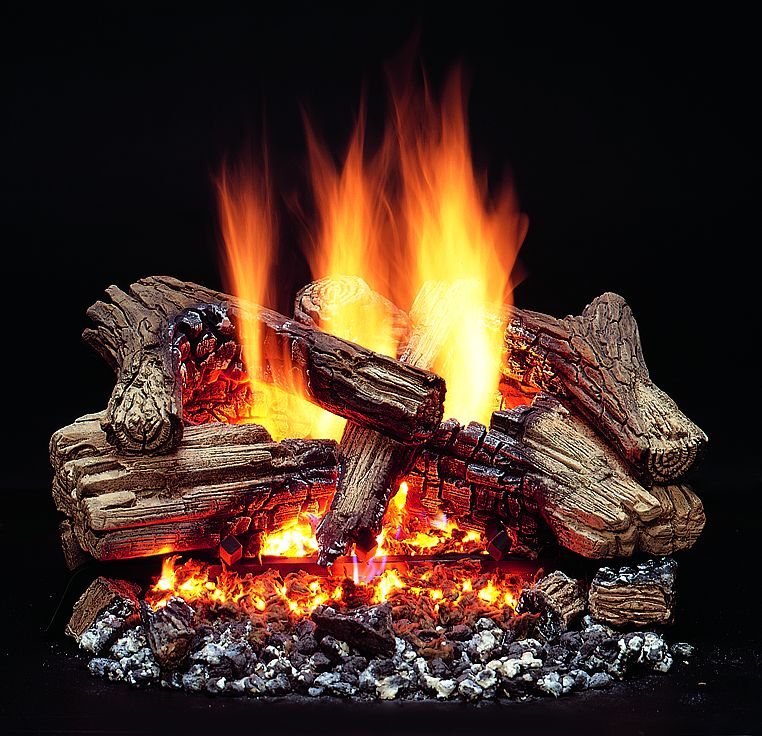
Log sets are simply a stack of ceramic logs atop a gas burner pan, with no firebox. They sit inside your existing fireplace and produce a realistic flame effect. Some log sets vent up the chimney, just like a wood fire, while others are ventless. They are relatively easy to install and affordable—but they don’t produce nearly as much heat as other gas fireplace options.
Benefits of Gas Fireplaces
Wood-burning fireplaces provide great ambiance, but they can’t beat the easy, no-fuss efficiency of gas.
- Effortless convenience: When you replace your wood-burning fireplace with a gas insert, you can say goodbye to the labor-intensive tasks of splitting, stacking, and hauling wood. There’s no need to build or tend to a fire, and you won’t have to deal with messy ashes or lingering smoky smells. You can start, adjust, and snuff out fires with the touch of a remote control.
- Precise temperature control: Many gas fireplaces come equipped with thermostat controls that allow you to set and maintain your desired room temperature effortlessly. The flame size adjusts automatically to provide the right amount of heat, ensuring optimal comfort without wasting energy.
- Enhanced energy efficiency: A wood-burning fireplace is a remarkably inefficient way to heat your home, since much of the heat escapes through the chimney. In contrast, gas fireplaces have efficiency ratings of up to 90%. Direct-vent models are particularly efficient, with a design that keeps up to 70% of the heat inside.
- Versatile placement: Unlike wood-burning fireplaces, which require a chimney, gas fireplaces can be installed virtually anywhere in your home, including upstairs bedrooms, basements, and even outdoors. This opens up a world of design possibilities and allows you to enjoy the warmth and ambiance of a fire in any space.
- Clean and safe heating: As part of its Burn Wise program, the Environmental Protection Agency (EPA) lists natural gas as a “more efficient, cleaner way to heat homes” than burning wood. They don’t produce smoke or creosote, which can build up in chimneys and pose a fire hazard. Many models also come with safety features like oxygen depletion sensors and automatic shut-off mechanisms.
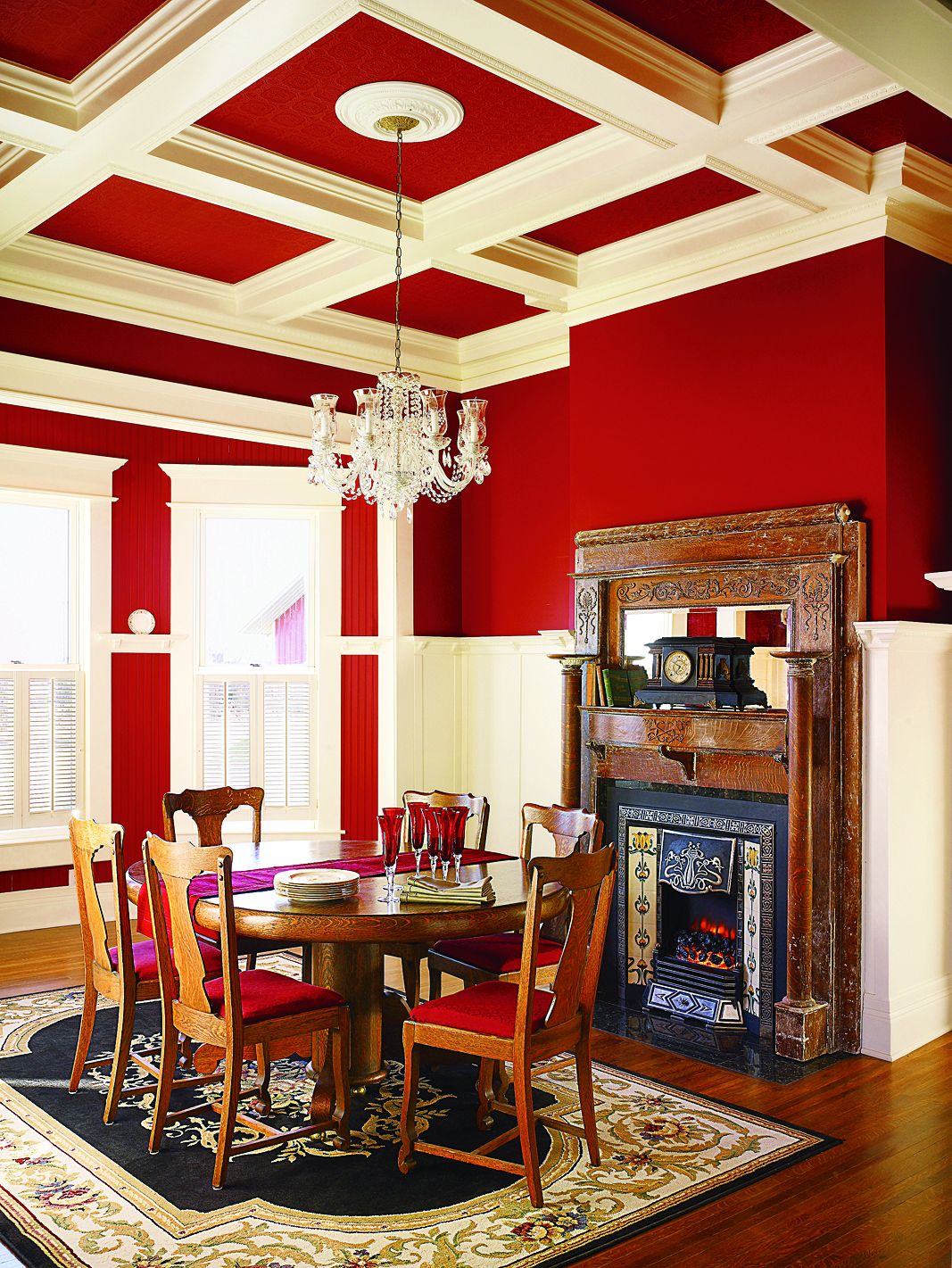
Choosing the Right Gas Fireplace
Selecting the perfect gas fireplace involves several key decisions, from budget and fuel type to venting options and desired features.
Budget
Gas fireplace costs vary widely, from $175 for a small log set from Home Depot to a range of $2,300–$8,000* for a gas fireplace insert. Considering your budget upfront can help you narrow down your options. Be sure to factor in the cost of installation, too.
* Unless otherwise noted, all cost data was sourced from contractor estimates used by Angi.
Natural Gas or Propane
Gas fireplaces run on either natural gas or propane, both of which burn more cleanly than wood or coal. Natural gas is generally cheaper per unit of energy, but it relies on utility pipelines that are not available everywhere. Propane costs more upfront but burns more cleanly and efficiently.
Heat Output (BTUs)
The heat output of your fireplace, measured in British thermal units (BTUs), should match the size and climate of the space you want to heat.
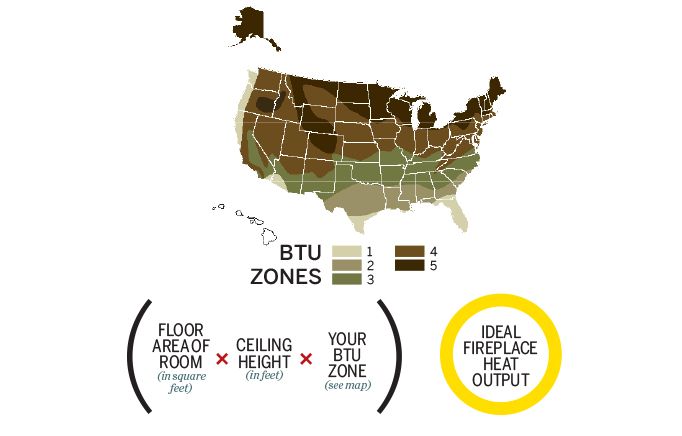
Gas fireplaces have a wide range of heat output, from about 7,000 to 60,000 BTUs. To determine which models generate enough heat to warm your room, multiply the floor area (in square feet) by the ceiling height (in feet) and your BTU zone (see map).
Vented vs. Ventless
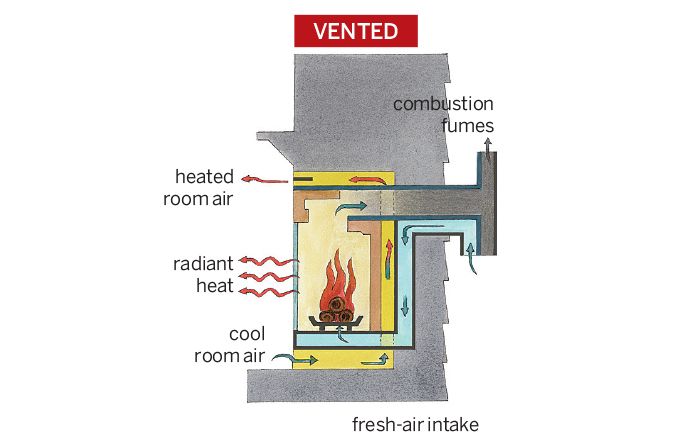
A gas fireplace doesn’t produce smoke or odors, but its flames do create pollutants, such as carbon monoxide and nitrogen and sulfur oxides. Vented fireplaces send these emissions outside via direct or natural venting.
Vent-free fireplaces don’t require venting and have no flue, so they can be installed anywhere. They’re up to 99% efficient because all their heat stays in the room—but so do all the pollutants.
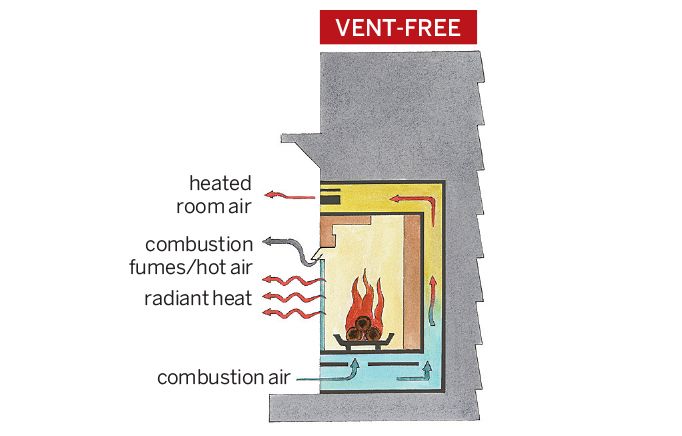
Because of concerns about air quality, indoor units are fine-tuned to burn extra clean, but they may not be allowed in all areas. Direct venting is generally the safest and most efficient option.
Aesthetics
With customizable surrounds, finishes, and media options, you can personalize your gas fireplace to seamlessly integrate with your existing décor or create a striking statement piece.
Traditional designs often feature realistic log sets or black ceramic lumps of “coal,” glowing embers, and ornate mantels, evoking the charm of a classic wood-burning fireplace. If you prefer a rustic vibe, consider a stone or brick surround with a roaring flame for a cozy cabin feel.
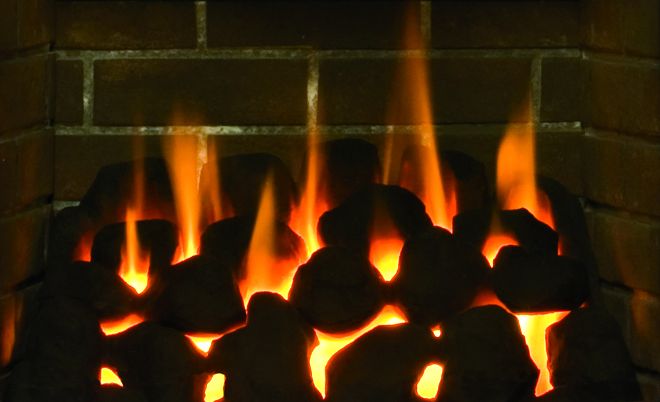
Modern fireplaces may showcase sleek lines, minimalist frames, and unique media like fire glass or crystals for a sophisticated look. Linear fireplaces with panoramic views of the flames offer a dramatic focal point.
Features To Look For
These upgrades enhance a fireplace’s convenience, comfort, and good looks:
- Variable-flame height adjustment: Allows you to dial in just the amount of heat you need, from a whisper of a flame to a roaring fire
- Wall thermostat control: Automatically adjusts the fireplace’s heat output to the temperature that you set manually or with a handheld remote
- Electronic ignition: Eliminates the need for a pilot light, saving up to $10 a month in fuel
- LED accent lighting: Adds a realistic flickering effect inside the firebox
- Battery backup: Ensures the fireplace will light during a power outage
- Built-in fan: Pulls indoor air into the space behind the firebox and pumps hot air out, heating a room in a hurry
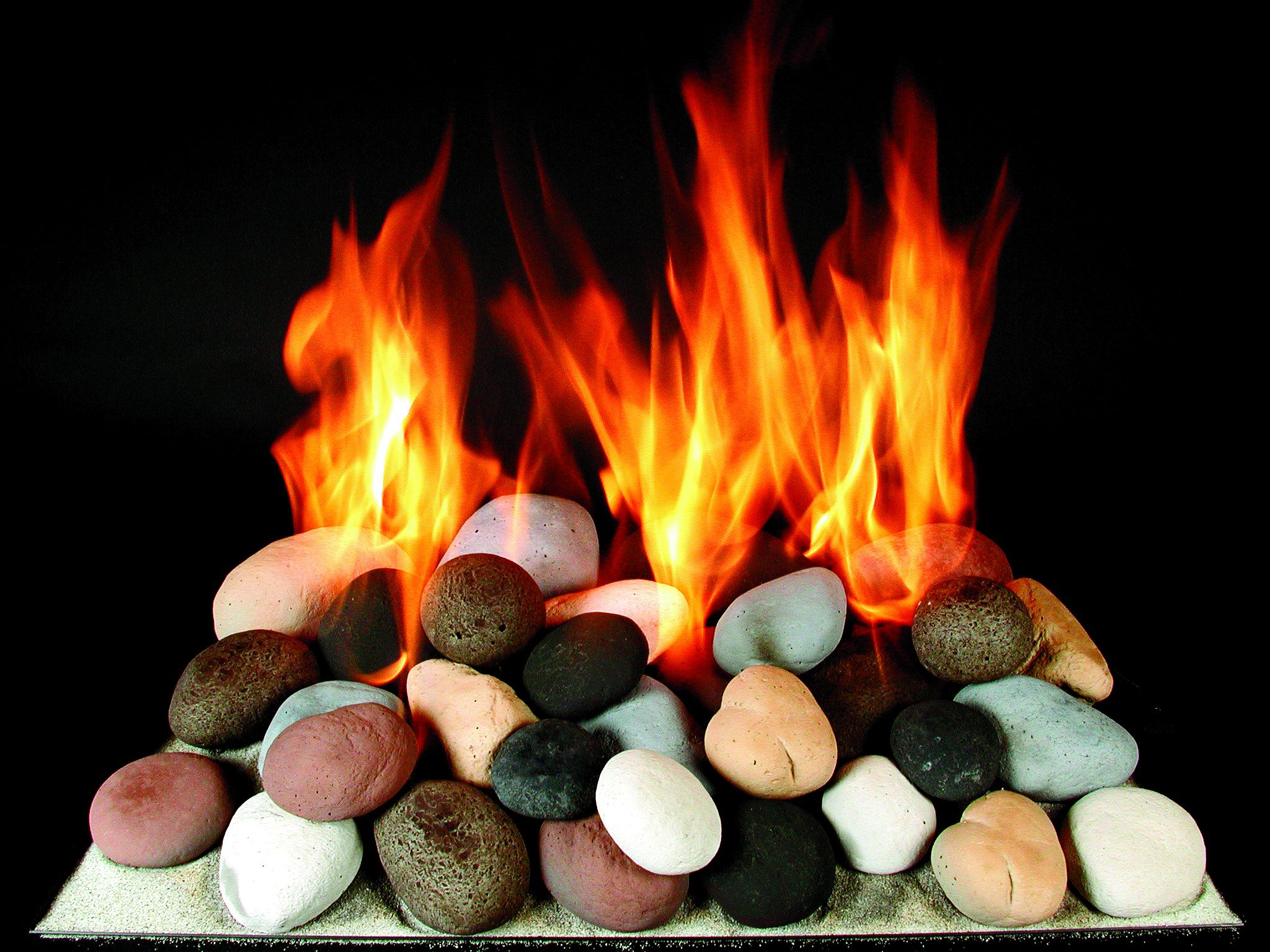
Gas Fireplace Installation and Maintenance
We recommend hiring a National Fireplace Institute (NFI)-certified technician for the installation. A professional can ensure that the fireplace is correctly connected to the gas line and complies with local building codes. Depending on your location, you may need permits and inspections for gas fireplace installation.
If you have a vented fireplace, ensure that the venting system is properly installed and sized for your specific model. For direct-vent fireplaces, the vent pipes must be sealed and terminate outside. For natural-vent fireplaces, the chimney or vent pipe must be in good condition and free of obstructions.
Maintenance Tips
Gas fireplaces don’t require a lot of maintenance, but regular cleaning and inspections can help extend the life of your unit. Here’s what we recommend:
- Annual inspections: Have your gas fireplace inspected annually by a qualified technician. They will check for gas leaks, clean the burner and pilot assembly, test safety features, and ensure proper operation.
- Regular cleaning: Regularly clean the glass front of your fireplace to prevent soot buildup. Dust the firebox and surround with a soft cloth or brush, and inspect the venting system for any blockages or damage.
- Checking for leaks: Periodically check for gas leaks by applying a soapy water solution to connections and looking for bubbles. If you detect a leak, turn off the gas supply and contact a professional immediately.
Safety Considerations
While gas fireplaces are generally safe and convenient, it’s important to be aware of potential safety hazards and take precautions.
- Carbon monoxide: Gas fireplaces can produce carbon monoxide, an odorless and poisonous gas. Install and maintain carbon monoxide detectors in your home to alert you to any problems.
- Flammable materials: Keep flammable materials—such as furniture, curtains, and decorations—a safe distance away from the fireplace.
- Children and pets: Never leave children or pets unattended near an operating fireplace, and consider using a fireplace screen to prevent accidental contact with the flames.
- Gas leaks: If you smell gas or suspect a leak, turn off the gas supply and contact a professional immediately.
Where To Place a Gas Fireplace in Your Home
Gas fireplaces offer incredible versatility, allowing you to transform any room into a cozy and inviting haven. Let’s explore some creative ideas for incorporating gas fireplaces into your home, from traditional living room settings to surprising nooks and corners.
Bathroom
A fireplace above a bathtub? Yup, you can do it with gas. This modern double-sided unit also shows its flames in the adjacent bedroom.
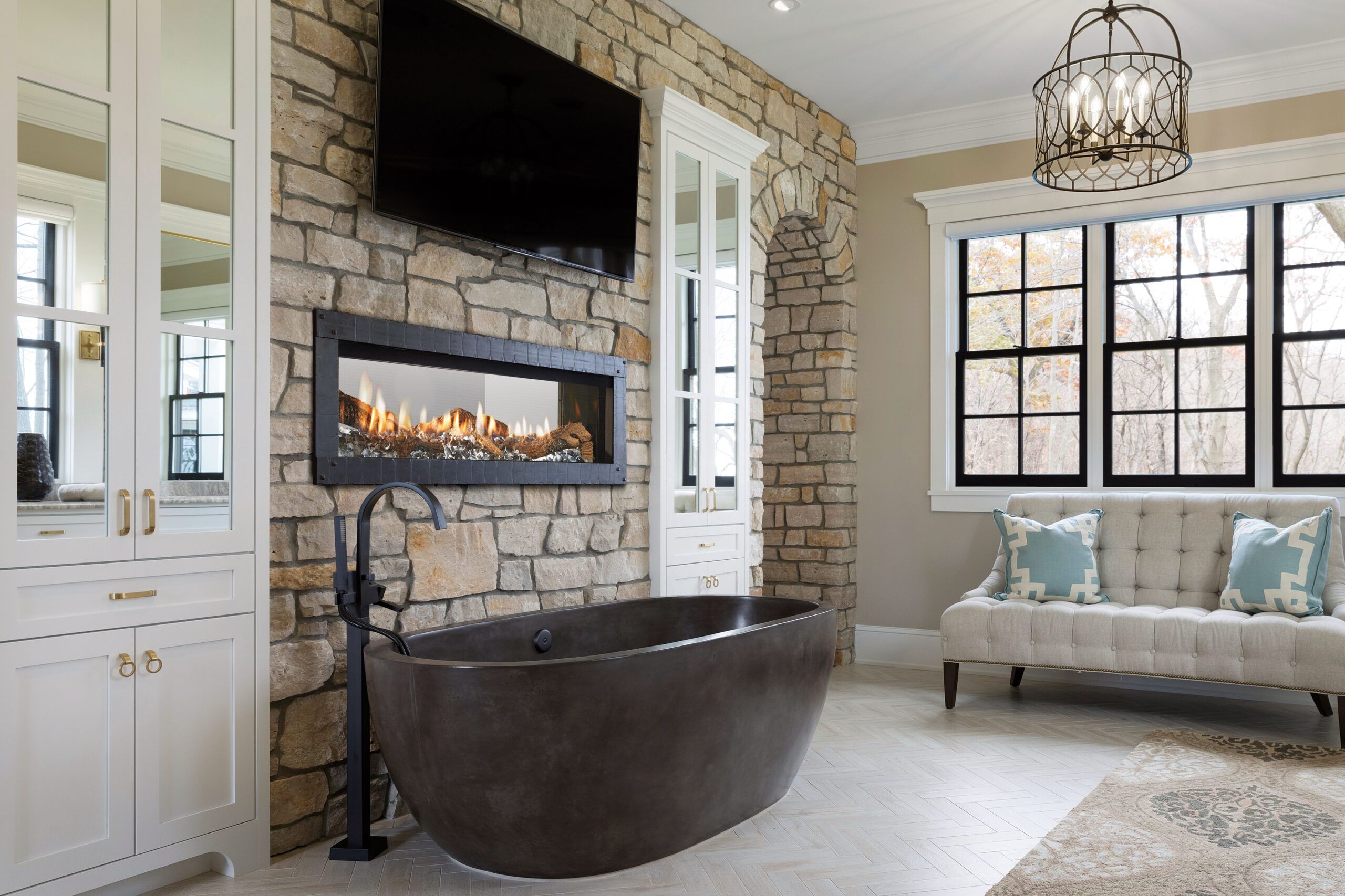
Shown: Mezzo double-sided linear gas fireplace, available in 36-, 48-, 60- and 72-inch, starting at $7,467, Heat & Glo
Bedroom
Not only is a fire romantic, but you can use a remote to adjust flame size and room temperature without lifting your head from the pillow.
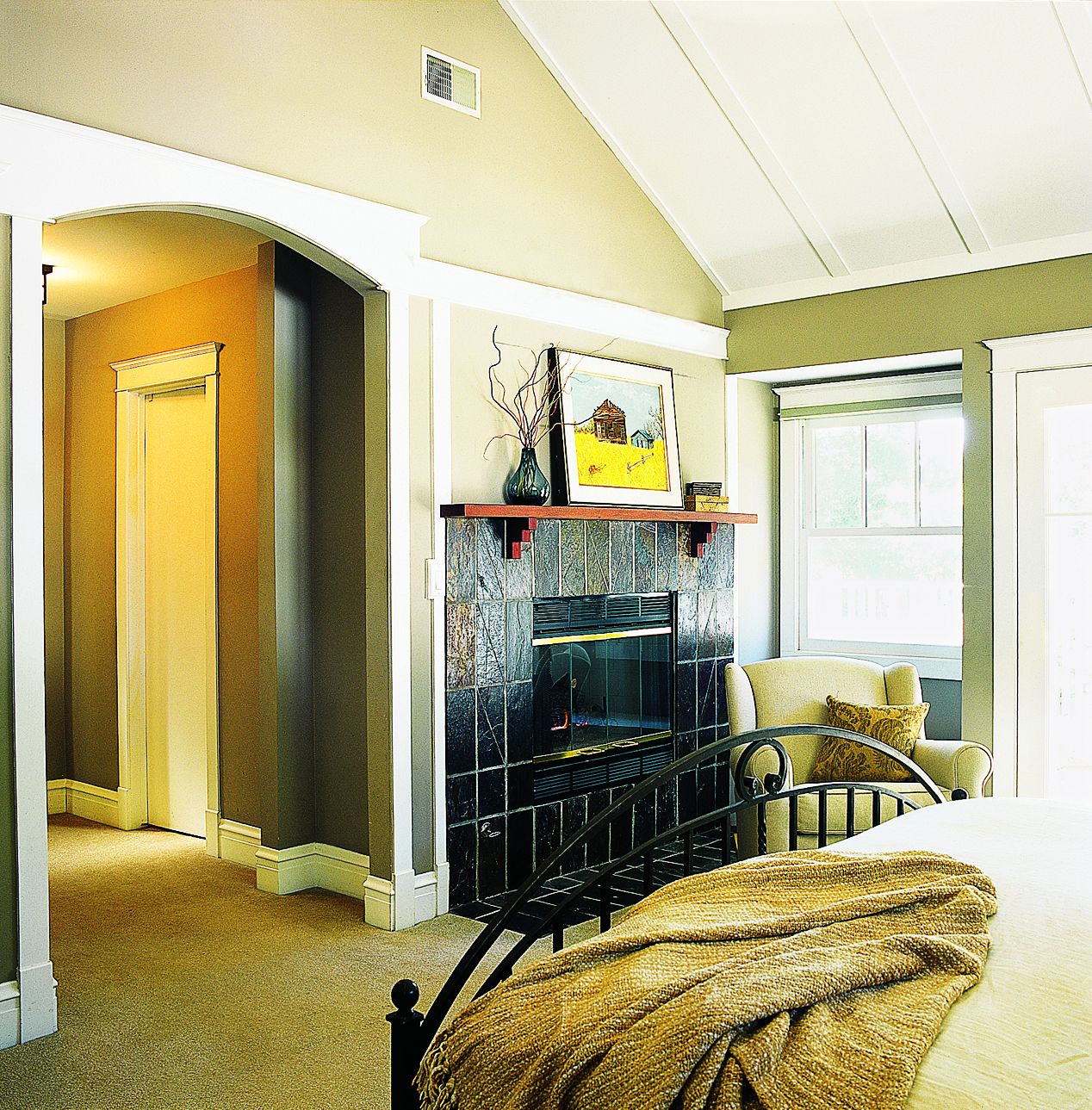
Similar to shown: Superior DRT2033 33-inch traditional direct-vent front-view gas fireplace, starting at $1,839, Superior Fireplace
Patio
Cut the evening chill and add a flickering glow to your surroundings with a low-profile gas fireplace—no chimney needed. Outdoor, vent-free units have no BTU restrictions or oxygen-depletion sensors.
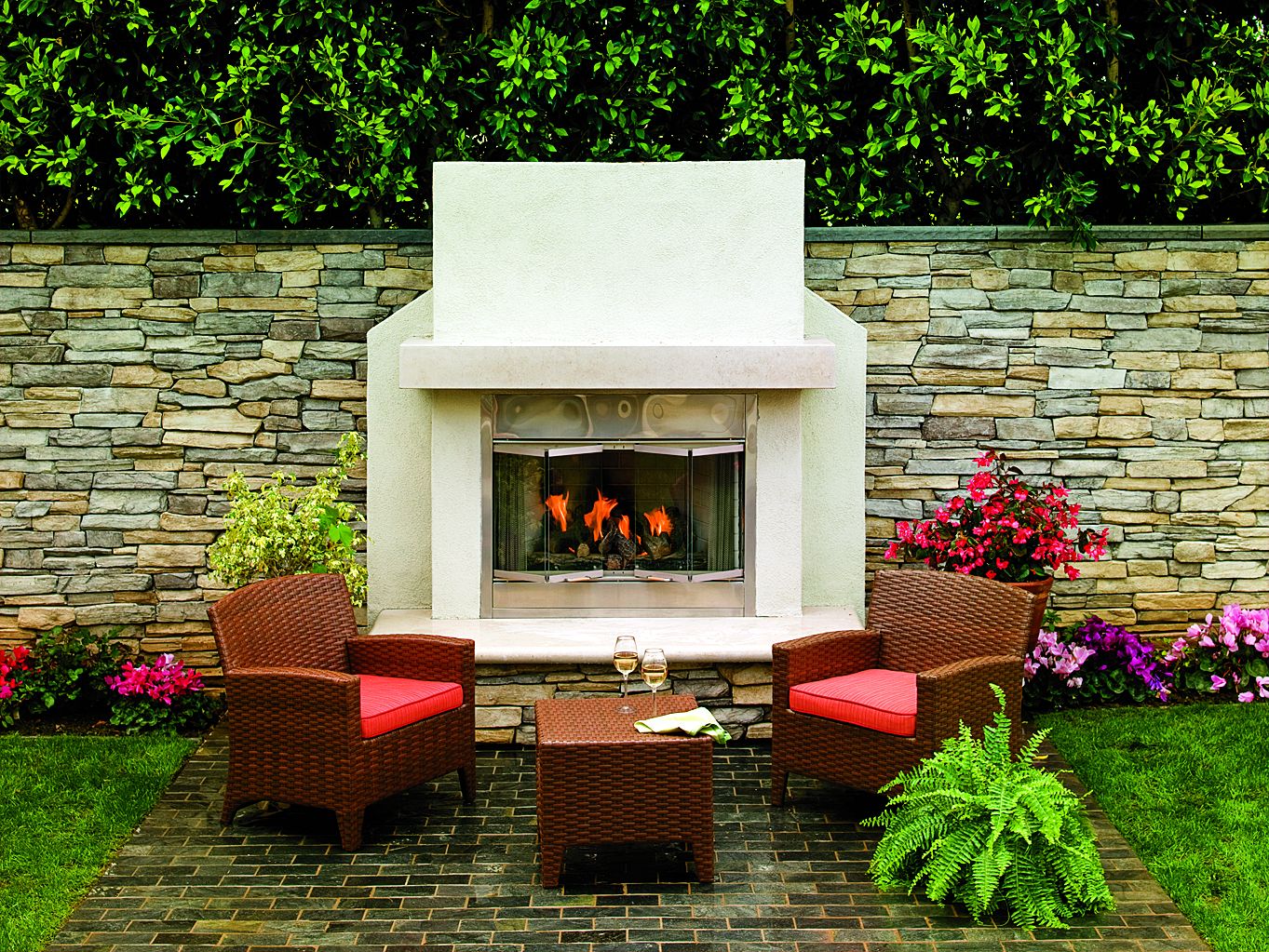
Similar to shown: Cottagewood outdoor fireplace, available in 36- and 42-inch, starting at $2,969, Majestic Products
Living Room
In this perennially-favored fireplace location, gas creates looks you could never get before, such as this linear wall of fire burning up through a bed of glass.

Similar to shown: Tall Linear Vector Series gas fireplace, available in 50-, 62-, and 74-inch, starting at $10,999, Napoleon
Basement
Direct-vent gas fireplaces are right at home in below-grade rec rooms, where wood-burning fires can smoke due to poor draft.
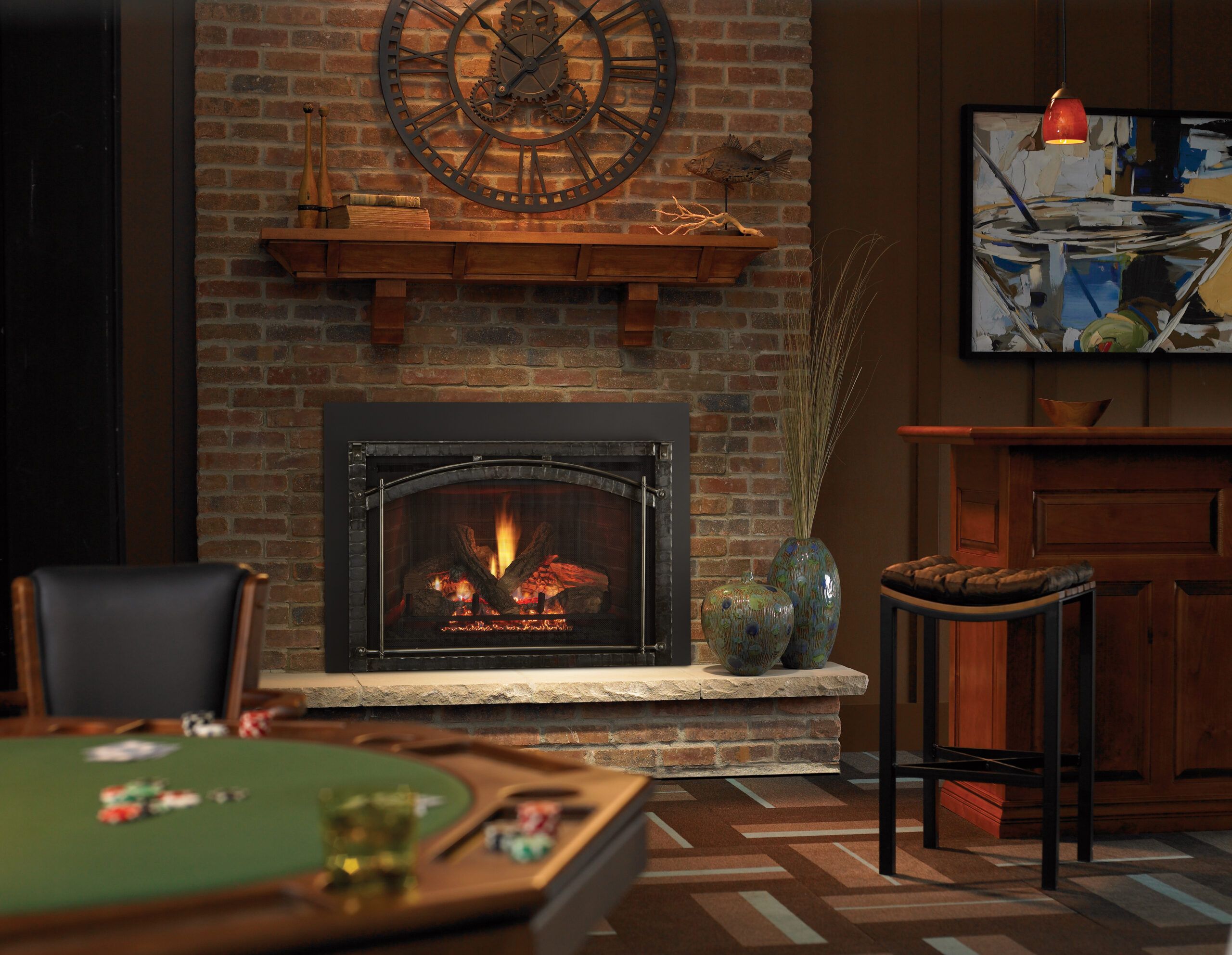
Shown: Escape direct-vent gas fireplace, available in 30- and 35-inch, starting at $5,226, Heat & Glo
Our Conclusion
Gas fireplaces offer an enticing blend of convenience, efficiency, and aesthetic appeal. Whether you’re seeking to modernize an existing fireplace, create a captivating focal point, or enhance your outdoor living space, a gas fireplace can transform your home into a cozy sanctuary.
As you shop for your new gas fireplace, remember to consider your budget, desired heat output, venting options, and aesthetic preferences. Consult with a qualified professional to ensure proper installation and maintenance, and always prioritize safety when operating your fireplace.
